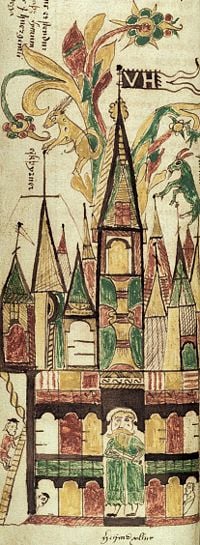Valhalla
Valhalla (Old Norse Valhöll, "Hall of the slain") is Odin's hall in Norse mythology, located in Gladsheim and is the home for those slain gloriously in battle (known as Einherjar) who are welcomed by Bragi and escorted to Valhalla by the valkyries.
Valgrind
The main gate is called Valgrind, which is described in Grímnismál as a "sacred gate", behind which are the "holy doors" and "there are few who can tell the manner by which it is locked". The hall itself has 540 doors, so wide that 800 warriors could walk through side-by-side. It is said that there is room enough for all those chosen. Here, every day, the slain warriors who will assist Odin in Ragnarök, the gods' final conflict with the giants, arm themselves for battle and ride forth by the thousands to engage in mock combat on the plains of Asgard. Those who die in the combat will be brought back to life. At night, they return to Valhalla to feast on roasted boar (Sæhrímnir) and drink intoxicating drink. Those who do not get to Valhalla go to the home of the dead (Hel), a place beneath the underworld (Niflheim), or one of various other places. Those who are lost at sea, for example, are taken to Ægir's hall at the bottom of the sea.
In addition to the valkyries and the Einherjar, a rooster named Gullinkambi lives there.
In Beowulf, it is called the shining citadel.
Modern Etymology
Valhalla is a 19th century English mistranslation of the singular Valhöll into a genitival plural form. A more literally correct English translation is Val-hall, but Valhalla is by far the most common form in general use.
Walhalla Temple
In the early 19th century, King Ludwig I of Bavaria ordered the construction of the Walhalla Temple, a place of honor for historically notable Germanic figures inspired by Valhalla, near Regensburg, Germany.
Popular Culture
References to Valhalla appear irregularly in modern popular culture.
| ||||||||||||||||||||||||||||||||
Credits
New World Encyclopedia writers and editors rewrote and completed the Wikipedia article in accordance with New World Encyclopedia standards. This article abides by terms of the Creative Commons CC-by-sa 3.0 License (CC-by-sa), which may be used and disseminated with proper attribution. Credit is due under the terms of this license that can reference both the New World Encyclopedia contributors and the selfless volunteer contributors of the Wikimedia Foundation. To cite this article click here for a list of acceptable citing formats.The history of earlier contributions by wikipedians is accessible to researchers here:
The history of this article since it was imported to New World Encyclopedia:
Note: Some restrictions may apply to use of individual images which are separately licensed.
